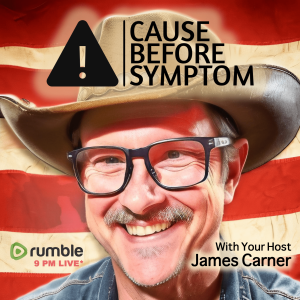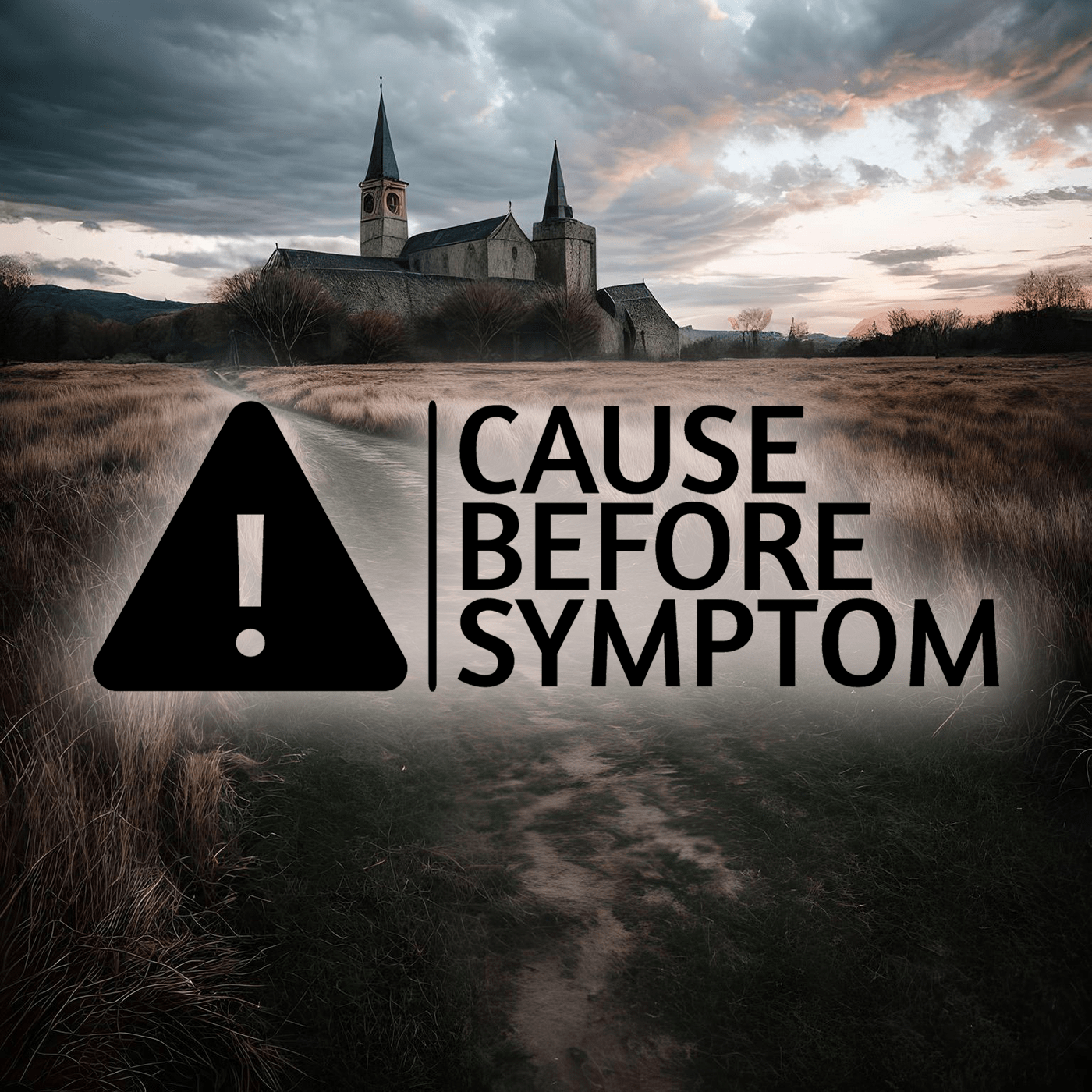Episodes

Thursday Oct 02, 2025
Thursday Oct 02, 2025
In a world reeling from engineered chaos, the elite have prepared the ultimate illusion: an alien arrival that will appear to end corruption, disease, division, and war. But behind the light and the promises lies the final deception — a counterfeit covenant, a global registry, and a throne not belonging to Christ, but to the Beast.
This 10-part series exposes the calculated steps leading to the crowning of the wrong king. From the comet 3I/ATLAS to Project Blue Beam, from von Braun’s deathbed warning to the post-COVID bait of “freedom through unity,” James Carner reveals how the Bank for International Settlements, NASA, and global occult networks have written a script that ends in false worship, biometric allegiance, and spiritual possession.
Each episode peels back another layer — from holograms in the sky to the registry of the beast, from the persecution of the remnant to the whispered guidanc

Wednesday Oct 01, 2025
Wednesday Oct 01, 2025
The Divided Empire: How East and West Compete for America While Serving the Same Throne exposes the orchestrated division of the United States not as a cultural or political accident, but as a strategic design by ancient bloodlines and spiritual powers. From the Vatican’s Black Nobility, led by the Orsini and Breakspear families, to the mercantile descendants of the British East India Company represented by the modern Lee dynasty, the show reveals how New York and Chicago operate as ritual command centers for opposing beasts that ultimately serve the same master: the Bank for International Settlements.
This 10-part series uncovers how Jesuits infiltrated spiritual infrastructure, how BRICS and the Federal Reserve are ritual reflections of one another, and how Trump’s rise and Islam’s tension in the West are being used to ignite a controlled holy war. Rooted in evidence from Occult Theocracy, Matrix III, The Committee of 300, and James Carner’s own Crown of Blood, this is not a theory—it’s a decoded blueprint of financial sorcery, spiritual submission, and end-time theater.
The show culminates with a call to reject both counterfeit crowns and return to the one true King whose Kingdom is not of this world—but whose victory is already assured.

Tuesday Sep 30, 2025
Tuesday Sep 30, 2025
The temple of God was never meant to be empty — not in Jerusalem, and not within you. Before its destruction, the temple was alive with priests, Levites, singers, scribes, gatekeepers, and guards, each fulfilling a divine role that mirrored the order of heaven. When the Catholic Church erased this knowledge and reduced deliverance to a ritual without restoration, believers were left with “empty houses,” vulnerable to demonic return. But God’s original blueprint was never destroyed — only hidden. This teaching restores the truth: after deliverance, you must not leave the temple vacant. You must invite the Holy Spirit to reign, and ask the Father to assign His angelic ministers to take their posts once again. A staffed temple is a fortress of light, and when the King returns, He will not come to ruins — He will come to a house alive with order, worship, and glory.

Monday Sep 29, 2025
Monday Sep 29, 2025
The Codex Gigas, known as “The Devil’s Bible,” is the world’s largest medieval manuscript—but its size is not its greatest mystery. Within its flesh-bound pages lies a hidden architecture of control: scripture paired with sorcery, medicine with necromancy, and a portrait of Satan enthroned across from a heavenly city. In this exposé, we uncover the Codex as more than a book—it is a registry, a spiritual and legal ledger forged through pact, precision, and preservation. From the legend of Herman the Recluse to its possession by Emperor Rudolf II and its survival through war and fire, the Codex emerges as a prototype for the systems of dominion now evolving in our digital age. This is not about history. It’s about who still owns the contract… and who remains bound to it.

Sunday Sep 28, 2025
Sunday Sep 28, 2025
Safe Before the Fire: God’s Promise to the Redeemed is a powerful and deeply scriptural broadcast designed to bring peace to the trembling heart. In a time when many Christians fear martyrdom, persecution, and being left to face Satan's wrath, this series walks through the unshakable pattern of divine protection. From the days of Noah to Lot, from Goshen to the wilderness flight in Revelation, the Word is clear—God removes, hides, or relocates His people before judgment falls.
Drawing from both the King James Bible and the Ethiopian canon, this ten-part message reveals that not all are called to die for the faith—many are called to live through divine preservation. Martyrdom is holy, but so is escape. The key is whether one has chosen the Son before the first death.
With biblical proof, apocryphal insight, and a spirit of deep encouragement, this message reaffirms the promises made to those sealed in Christ: you will not be struck with the wicked, not suffer the wrath prepared for the dragon’s kingdom, and you will be safe before the fire.
This isn’t false hope. It’s the covenant pattern written in blood.

Sunday Sep 28, 2025
Sunday Sep 28, 2025
The Blood of the Serpent: Crude Oil, Pharmakeia, and the Rise of the Beast System is a prophetic exposé uncovering how crude oil — the so-called lifeblood of modern civilization — is not merely an industrial resource, but a spiritual counterfeit. Through ten gripping chapters, the series traces oil’s transformation from fuel to pharmakeia, from energy to sorcery, and from underground commodity to the backbone of the beast system prophesied in Revelation.
Drawing from historical documents, Rockefeller-funded education reforms, geopolitical warfare, environmental devastation, and the petrochemical foundations of modern medicine and AI, this series lays bare the global covenant forged in crude. It shows how the serpent’s blood has replaced God’s breath — in our bodies, our rituals, and our cities — and calls for a radical exodus back to the healing leaves of Eden.
This is not just a warning. It is a map. A summons. A cry to come out of Babylon, before the image speaks and the smoke rises for the last time.

Friday Sep 26, 2025
Friday Sep 26, 2025
Satan’s Little Season Ends in 2026?
For 250 years, a global deception has unfolded in plain sight — masked as liberty, progress, and enlightenment. But Revelation 20 warned us: after Christ's reign, Satan would be loosed for a short season to deceive the nations one last time. That season began in 1776 — the year of the American Revolution and the founding of the Bavarian Illuminati — and it ends in 2026.
In this ten-part exposé, we trace the rise of a counterfeit kingdom:– The replacement of the true Ark with a throne of digital sorcery– The suppression of Enoch, Jubilees, and the Ethiopian canon that foretold this deception– The construction of false portals and alien saviors to mimic Christ’s return– And the final convergence of financial, genetic, and spiritual control systems
At the heart of it all stands Ethiopia, the hidden custodian of God’s covenant — preserving the Ark, the true scriptures, and a living rebuke to Babylon. As the short season ends, the enemy prepares his last move. But the throne still stands, and the King is coming.
This is not speculation. It’s Revelation unfolding.
#ShortSeasonEnds #EthiopiaArk #Revelation2026 #AlienDeception #WatchersReturn #BookOfEnoch #KebraNagast #JesuitAgenda #BabylonSystem #CBDCMark #ArkOfTheCovenant #DigitalThrone #SatanLoosed #FalseMessiah #Transhumanism #HomoBorgensis #ProjectBlueBeam #EndTimeProphecy #HiddenRemnant #ChristReturns

Friday Sep 26, 2025
Friday Sep 26, 2025
Operating Sovereign: The Power of the Unincorporated Association
Watch this on Rumble: https://rumble.com/v6zhako-operating-sovereign-the-power-of-the-unincorporated-association.html
Kirk Carmichael at Unincorporated Associations
https://unincorporatedassociations.com
info@unincorporatedassociations.com
11440 W. Bernardo Court, Ste 300
San Diego, CA 92127
619-603-0233
Join the 10 minute call every day! https://register.unincorporatedassociations.com/join_the_call
“The secret to success is to own nothing, but control everything.” ~ Nelson Rockefeller
Begin Your Own Unincorporated Association Today!
What is an Unincorporated Association?
When you reorganize your financial affairs and shift your tax liability onto a private organization by beginning a member-based entity called an "Unincorporated Association."
A private Unincorporated Association is a Secretary of State registered entity offering a more convenient, flexible, and cost-effective way to manage assets and transactions. Unlike corporations and LLCs, this association is private and not available to the public, giving you the privacy and control you desire.
Tax Exempt EIN Number: EIN Number assigned with 575-E status.
Complete Control Over Membership: As a member, you have the final say over all transactions and activities.
Privacy: Your association is not publicly listed, ensuring your complete privacy.
Asset Management: Assign ownership of property (vehicle, house, bank account, etc) to the association to limit/eliminate personal liability.
Easy Transfer of Assets: Sale or transfer of assets is made simple via membership resignation and reassignment as opposed to subjecting the asset to taxes and fees of selling the asset.
Minimal Ongoing Costs: Lifetime registration with no annual fees (vs Corp. & LLC’s are $800 per year)
Get your UNA questions answered by an attorney!*
Meet Chrystan,
Chrystan Carlton began her legal and professional career with the mission to make the road to entrepreneurship and social enterprise development accessible.
Using her expanded negotiation, finance, and legal skills, she can help entrepreneurs and social enterprises bring their vision to life.
With more than 25 years of experience as a business professional and 10 years of experience as a licensed attorney, Chrystan Carlton is well-seasoned in a wide range of business and legal concerns.
Her areas of expertise are comprehensive, including:
Tax Litigation,
Business Entity Formation,
NonProfit 501(c)3 filings,
Business Strategy,
and more.
Chrystan excels in Contract Drafting, Corporate Compliance, and Start-up Financing, covering everything from SAFE agreements to international commerce.
Chrystan is dedicated to simplifying legal challenges and empowering entrepreneurs and social enterprises to succeed.
https://register.unincorporatedassociations.com/bookwchrystan

Thursday Sep 25, 2025
Thursday Sep 25, 2025
In this hour we trace the joker from ancient carnival to modern pop culture and show how a sanctioned figure of inversion quietly became a cultural grammar that normalizes exception, erodes reverence, and baptizes mockery as virtue. We move from Bakhtin’s carnivalesque and Rome’s Saturnalia into medieval Feast of Fools, follow the tarot Fool’s liminal initiation into the nineteenth-century playing-card Joker, and then track the image’s ritual adoption by elite fraternal circles and its mass marketing in comics, film, and memes. Along the way we diagnose the devil’s tactic: using humor as plausible deniability to trivialize holiness, weaponize cruelty, and teach a generation that cleverness can substitute for conscience. The show closes with pastoral tools for discernment that do not ban joy but reclaim it—teaching reparative humor, restoring practices of reverence, and rehearsing the gospel’s holy inversion so laughter heals rather than hardens.
#joker, #jester, #carnivalesque, #feastoffools, #tarotfool, #wildcard, #mockery, #discernment, #spiritualwarfare, #consecratedjoy, #prophetichumor, #eliteculture, #culturalcritique, #satire, #reclaimingworship

Wednesday Sep 24, 2025
Wednesday Sep 24, 2025
This episode explores the biblical and Ethiopian command to expose evil, showing that silence is complicity and obedience demands revelation. From the prophets to the apostles to the Ethiopian fathers, scripture is saturated with warnings against concealing corruption. We then trace the patterns we’ve uncovered in our mission: bloodline dynasties, financial secrecy, propaganda loops, false treaties, and genetic manipulation. History confirms the same truths through the Panama and Pandora Papers, Cambridge Analytica, and 1MDB. In real time, our own work has been echoed by journalists, researchers, and independent voices, proving that our labor has not been in vain. Though the cost of obedience is ridicule and resistance, the hope of light is greater, for darkness cannot overcome it. The call now is to persevere, keep exposing, and keep shining until Christ Himself ends the counterfeit kingdom.
#ExposeEvil #ShineTheLight #ScriptureReveals #EthiopianCanon #UnfruitfulWorks #TruthInDarkness #NoMoreSilence #PropagandaLoops #BloodlinePower #FinancialSecrecy #FalsePeace #GeneEditing #RighteousResistance #PersevereInTruth #CauseBeforeSymptom

Cause Before Symptom
For over 1,000 years, planet Earth has been controlled by two bloodline familes who play good and evil giving the appearance of duality while the sleeping commoners fall prey to their agendas. By using religion, they control the past, present and future through ancient and new black magic technology manipulating events for greed and control.






